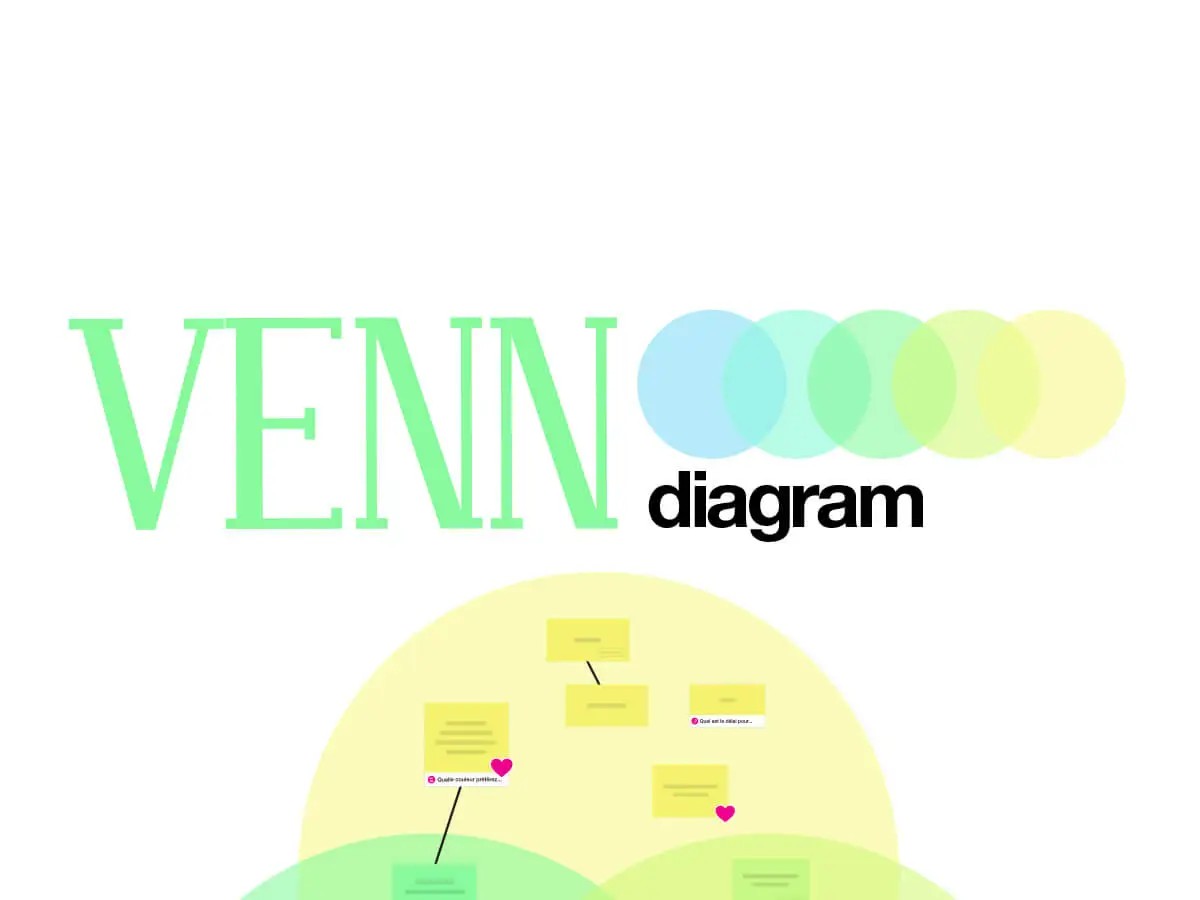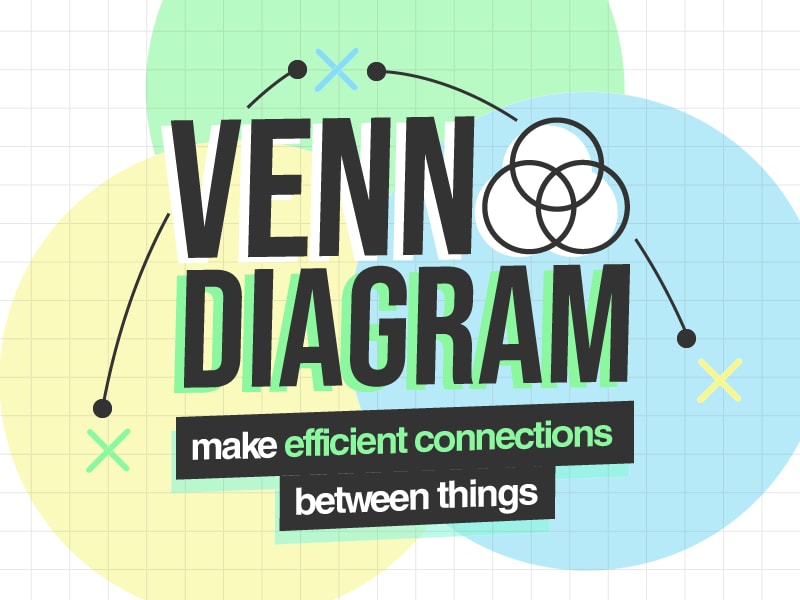Who invented the Venn Diagram?
There is some confusion about the original creator of the Venn diagram. Some people say it was Leonhard Euler, while others credit Lewis Carroll. John Venn is also sometimes given credit. Of Leonhard Euler, Lewis Carroll and John Venn, who is the originator of Venn diagrams? Are Eulerian and Venn diagrams referring to the same thing, or are they totally different concepts? Let’s try to find out!

With this ready-to-use template, easily identify the existing relationships between multiple axes of a given need, and find the most appropriate solution.

Venn Diagrams
A Venn diagram (also called a logic diagram) is a diagram that shows all the possible logical relationships in a finite collection of different information sets. They are used to teach elementary set theory, as well as to illustrate simple relationships in probability, logic, statistics, linguistics and computer science.
Venn diagrams are a very versatile tool and can be used in a wide variety of situations. For example, they can be used to:
- Compare and contrast different objects;
- Show how different groups are related to each other;
- Represent any kind of relationship between different sets of data.
Venn diagrams were introduced in 1880 by John Venn, in an article entitled On the Diagrammatic and Mechanical Representation of Propositions and Reasonings in the Philosophical Magazine and the Journal of Science, on the various ways of representing propositions by diagrams. The use of these types of diagrams in formal logic, according to F. Ruskey and M. Weston, is "not an easy story to trace, but it is certain that the diagrams that are commonly associated with Venn, in fact, appeared much earlier.” They are rightly associated with Venn, because he examined and formalized their use, and was the first to generalize them.
However, the first origins of this type of diagram go back at least 600 years earlier. In a 1969 article tracing the history of these diagrams, M.E. Baron explains that the philosopher and logician Ramon Llull (sometimes spelled Lull), from Mallorca, used a similar type of diagram in the 1200s. She also credits the German mathematician and philosopher Gottfried Wilhelm von Leibniz with creating similar diagrams in the late 1600s.
Who was Venn?
John Venn (1834-1923) was an English logician (he studied logical thinking) and philosopher who is remembered for inventing the diagram that bears his name - the Venn diagram.
Venn was raised by his father, who was a minister in the Church of England. John’s mother died when he was very young. He went to Cambridge University, where he won a mathematics scholarship during his second year. Although he excelled in mathematics at school, he became a minister like his father and grandfather after graduation.
Venn never stopped thinking about mathematics and so, after doing religious work for a few years, he returned to Cambridge in 1862 where he taught logic and probability. He got married in 1867 and had a son, John. His son John eventually became the president of Queen's College at Cambridge University, where he did important research projects with his father.
Venn published a first treatise The Logic of Chance (1866) and, 15 years later, in 1881, Symbolic Logic, with the geometrical representation of propositional logic in the form of closed curves without double points ("potatoes" or "potatoids" = potato-shaped...) simplifying the understanding of complex syllogisms, already brilliantly facilitated by de Morgan half a century before. In fact, Euler had already used this kind of representation for logical reasoning in the form of circles or ellipses (sometimes called Euler representation).
Euler diagrams
Euler diagrams are named after the Swiss mathematician Leonhard Euler, who invented them in the 18th century, while Venn diagrams did not gain popularity until the late 19th century.
A Euler diagram is also a visual way of representing relationships between sets or groups of things.
Euler diagrams consist of overlapping shapes, usually circles or other simple geometric shapes. The areas where the shapes overlap represent the relationships between the sets or groups that are being represented.
For example, a Euler diagram could be used to show the relationships between different types of animals. The overlapping areas might represent animals that are related to each other, such as mammals, reptiles, and amphibians.
Euler diagrams can be helpful for understanding complex relationships between different things. They can also be used for making predictions or for testing hypotheses.
What is the difference between Euler and Venn diagrams?
The Venn diagram is a type of Euler diagram. The main difference between the two is that the Venn diagram uses overlapping circles to represent relationships, while the Euler diagram can use any type of shape. Euler diagrams tend to be more simplified, while Venn diagrams usually have more than three overlapping circles.
While Euler may have been the first to use this type of diagram, it was John Venn who really brought it into the public eye.
Carroll diagrams
A contemporary of Venn, Lewis Carroll (1832-1898) proposed a representation in which the "universe" is a square, and each attribute divides this square into two equal parts. Thus, two attributes divide the universe into four, three attributes into eight, and so on.
Renouncing the connectedness of the subdivisions, Carroll could represent up to eight simultaneous attributes. Moreover, he retained the Venn principle of marking unknown regions as empty and known regions as non-empty. The three Euler’s configurations for n=2 become Carroll’s.
Carroll diagrams are a type of Venn diagram where the regions do not overlap. Carroll diagrams are a useful tool for visually representing the relationships between different sets of data. For example, they can be used to show how different groups are related to each other, or to compare and contrast different objects.
There are many different types of Carroll diagrams, but the most common one is the basic Carroll diagram with three non-overlapping regions.
What is the difference between Venn and Carroll diagrams?
The main difference between Venn and Carroll diagrams is that Venn diagrams usually have more than three overlapping circles, while Carroll diagrams have three non-overlapping regions.
Conclusion
Eulerian and Venn diagrams are often used interchangeably, but they are not actually the same thing. Eulerian diagrams tend to be more simplified, while Venn diagrams usually have more than three overlapping circles. Carroll diagrams are a special type of Venn diagram where the regions do not overlap.

Find out more about concrete examples of how to use a Venn diagram in everyday problem solving.

Unlock your teamwork potential
For free, make your first steps to top-tier work efficiency with the Klaxoon Work Collaboration Platform.